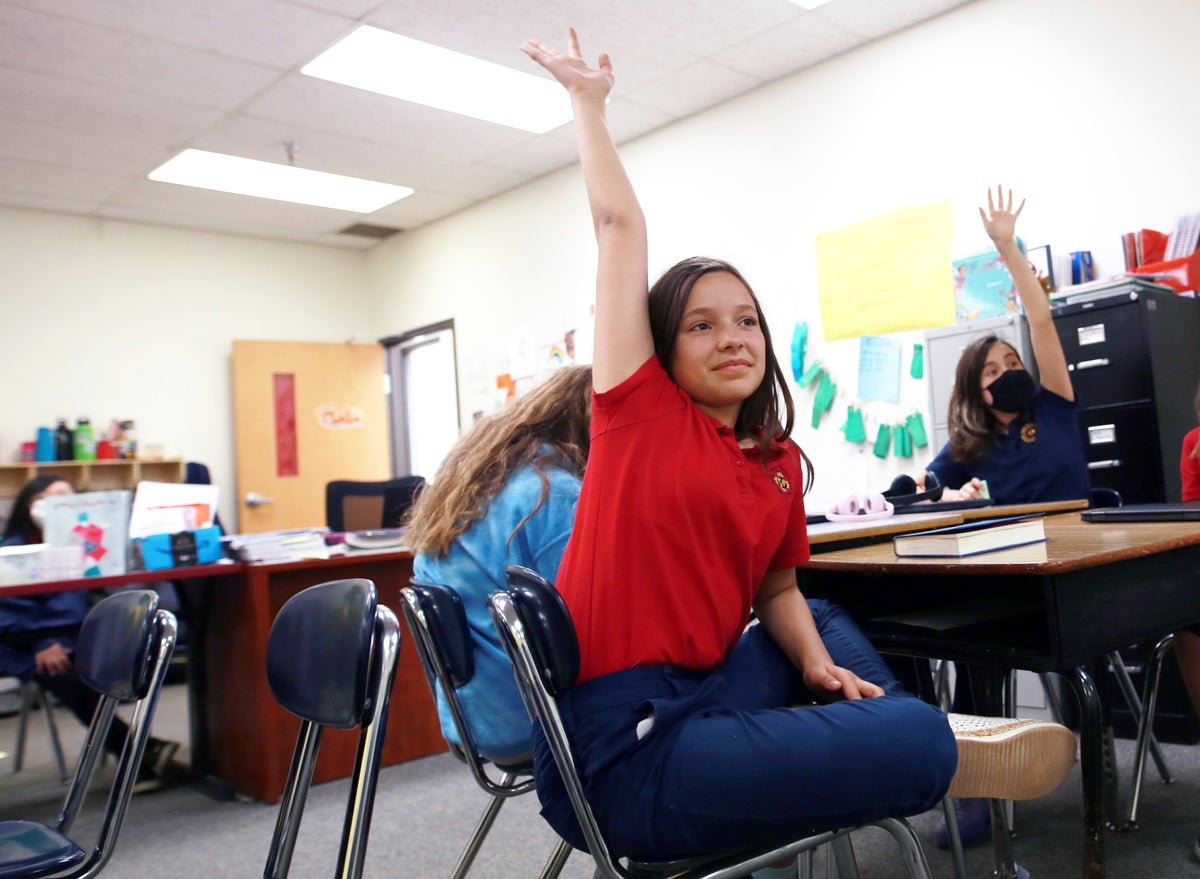
Jacqueline Powell and her fourth grade classmates toiled over pencil and paper to write a letter in Spanish about what they did in class this year.
Powell explained the assignment in perfect Spanish before struggling to translate the words to end her sentence. The 10-year-old charter school student raised her forearms to her temples in a show of mental effort, making her large round glasses seesaw up and down.
That struggle, fought every week at the New Mexico International School in Albuquerque, has put her speaking ability far ahead of some of her high school peers. It has allowed her to speak in Spanish with her grandmother, who is from Chihuahua, Mexico, and she has fostered a secret language between her and her mom, whose husband and step children can’t speak Spanish.
While dual language programs are offered in thousands of schools across the U.S., New Mexico is the only state where the right to learn in Spanish is laid out in the constitution.
Dual language programs like the one at the New Mexico International School are championed by Hispanic parents who want their children to cultivate cultural roots. They are also seen by education experts as the best way for English learners to excel in K-12 schools.
The question for lawmakers in the nation’s most heavily Hispanic state is why New Mexico’s dual language programs aren’t being used by the students who most need them.
Legislative analysts are expected in the coming weeks to release a report that will highlight challenges facing dual language and other multicultural programs. It will include a look at decades-old trends such as a lack of oversight by education officials, declining participation, and a reduction in the number of multicultural programs, said Legislative Finance Committee spokesman Jon Courtney.
The report also will acknowledge the lack of information about how well language programs are doing after two years without comprehensive academic testing due to the pandemic.
The number of dual language immersion programs has increased from 126 before the pandemic to 132 last year.
State officials are supposed to assess the programs every three years. But the New Mexico Public Education Department has done only one in-person visit and evaluated only one school over the past three years, said department spokeswoman Judy Robinson.
The department has started a series of forums for parents around the Hispanic Education Act, a state law that informs multicultural programs.
While there isn’t a consensus among educators as to how to best teach young children languages, a New Mexico court found in 2018 that well-run dual language programs are the “gold standard” for English learners.
The alternative, more popular in Arizona, is to separate children out for remedial instruction.
In New Mexico, English learners make up a larger share of dual language program participants. They comprise 63% of participants in the current school year, up from 53% last year.
At the New Mexico International School in Albuquerque, around half of students are Hispanic, like Jacqueline, and reflective of the city’s population.
“Many of their parents are trying to reclaim the language,” school principal Todd Knouse said.
English-speaking parents say they have an easier time learning about the benefits of dual language programs and jumping through the hoops to get into charter schools. The schools are free but don’t provide bussing.
“It’s almost like a privilege type of experience to get your kid into these programs because it does take a lot of research. Tracking down the programs, the distance of how long you’re willing to drive, the (admission) lottery,” said Mary Baldwin, 34, whose daughter attends the Albuquerque school.
“And then there’s so much shame that gets placed on the Spanish language or the culture itself,” she said. “Some families might not be aware that being bilingual is a huge strength not just culturally but also professionally.”
Baldwin immigrated to the U.S. from Honduras when she was 10. Her daughter is the same age now and is fluent enough to cook banana-leaf-wrapped tamales with her Spanish-speaking grandmother as a result of the dual language program.
Fans of New Mexico’s programs say they elevate Spanish-speakers’ skills and give them confidence in an environment where everyone is equal as they learn a new language. The programs also increase fluency and literacy in their home language.
“It’s generally beneficial to have two languages,” said Stephen Mandrgoc, a University of New Mexico historian who has studied bilingual programs in the southwest and oversees Spanish colonial heritage programs.
When it comes to languages spoken by New Mexico’s Native American tribes and pueblos, there are some state laws that protect student rights. Still, only two dual language programs are offered in Native American languages — both in Diné, the language of the Navajo people.
Some tribes like Jemez Pueblo face a more pressing existential threat to their language because of a small population and cultural taboos that limit the creation of language materials. Other tribes like Santa Clara Pueblo say underinvestment is a problem.
New Mexico officials have appropriated millions of dollars to support curriculum projects, but much of the funds go unspent. Advocates say one problem is the time in which grants must be spent, from less than a year to sometimes as short as a month before it reverts back to the state.







